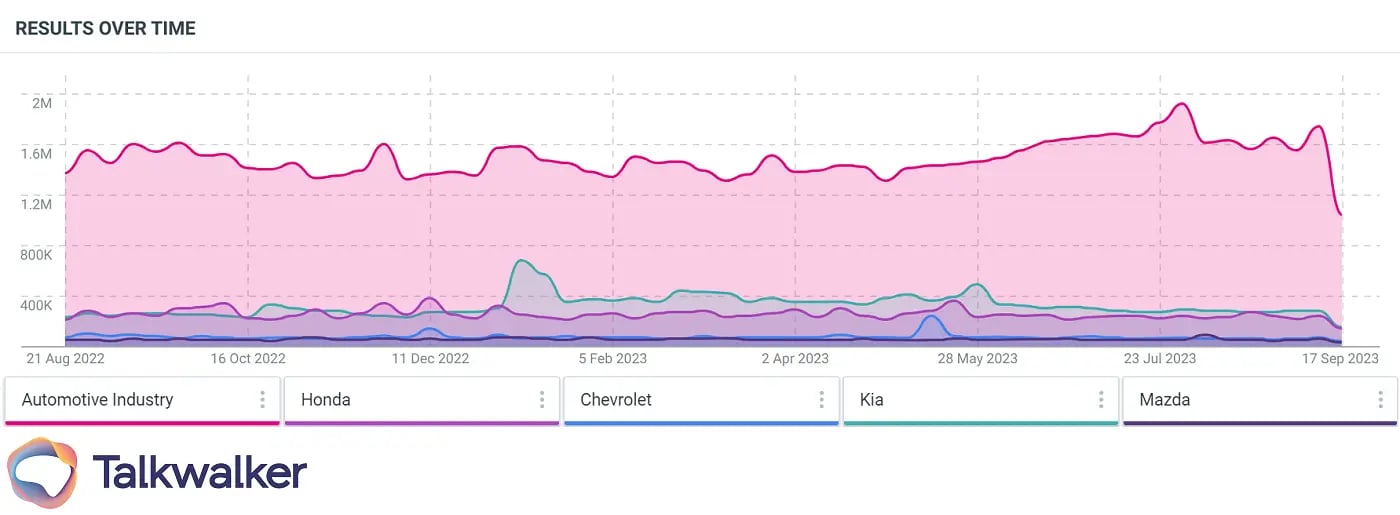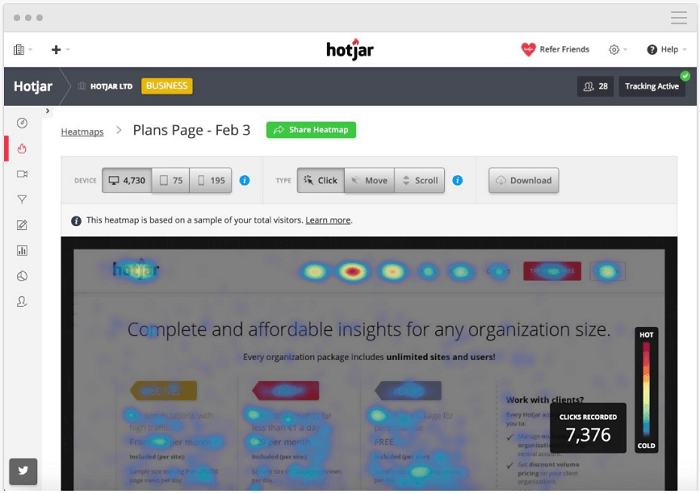Your brand relies on its reputation to attract and retain customers. It’s your most valuable asset and has to be protected and nurtured.
How people feel about your business influences their behavior – whether they want to purchase from you, work with you, invest in your growth, and more.
But how do you find out what people are thinking – and even saying – about your brand?
That’s where measuring comes in. If you don’t report the outcome of your PR campaigns, how will you know what’s working and what to improve?
In this guide, the PR measurement and reporting experts at Talkwalker explain how to quantify your PR efforts through examples and tool suggestions.
What is PR measurement?
PR measurement is simply the review of the success of PR campaigns. It may include the reporting of a range of metrics based on audience or readership, share of voice, brand sentiment, coverage value equivalent, website backlinks, and more.
Until recently, PR professionals used Advertising Value Equivalents (AVE) to evaluate their PR efforts.
This method lent itself to many traditional PR campaigns, which were otherwise difficult to measure and report on – such as print ads, which were measured by finding the reach of the publication and multiplying it by the cost of the advert placement.
AVEs were designed to demonstrate the financial value of PR efforts, but they never provided an accurate method for measuring campaigns. For example, a news story is not an ad. They’re different and should be measured accordingly.
So, AVEs were typically regarded as the standard for PR measurement, until 2010 – when a team of PR experts met in Barcelona to discuss a methodology for PR measurement and the dissolution of AVEs.
What came out of this meeting was the Barcelona Principles – now considered a universal measurement standard. They recognize the need for outcome – rather than output-based PR measurement. They also readily accept social media as a means of communication.
The original principles from 2010 have since been updated – in 2015, and again in 2020 – and comprise seven general guidelines that you should implement when measuring your PR efforts, as outlined below:
 Check here for more information about The Barcelona Principles.
Check here for more information about The Barcelona Principles.
The process is simple: start with goals, then check the results to see whether goals were scored.
When PR goals equate with business results, determining the success and value of your PR efforts is easier. You’ll identify what’s working and what isn’t, so you can improve your marketing strategy, and identify what’s bringing ROI.
Why measure PR campaigns?
The PR industry is estimated to generate annual revenue of $20.4 billion a year in the US alone.
And with so much spent on brand awareness, it’s no surprise top management demands proof of ROI and impact. They want to make sure they’re getting what they pay for.
Without being able to provide these insights, PR professionals and wider marketing teams risk losing their budgets.
So, it’s alarming that 50% of PR and communications professionals claim that measuring impact and proving ROI is their biggest challenge.
For those able to confidently and accurately measure and report on the business impact of their PR efforts, the potential rewards are huge…
Benefits of PR measurement
Never underestimate the benefits of measuring your PR campaigns. The insights available will aid decision-making and future planning.
Some of the main benefits of PR measurement include:
- Offering a clear picture of your business’ performance and proving the value of your PR campaigns in reaching your business objectives.
- Revealing what’s working and what isn’t, so you can tweak campaigns to improve outcomes.
- Evaluating past performance to help you plan successful future PR strategies, set your budget, and establish KPIs.
- Arming your team with data, ready to defend your brand during a reputation crisis.
PR measurement starts with planning
PR measurement – often called PR evaluation or PR analysis – is simply checking if you’ve met the predetermined objectives and goals of your campaign.
It’s the first Barcelona Principle – “setting measurable goals is an absolute prerequisite to communication planning, measurement, and evaluation” – and the first step in planning your marketing strategy.
Defining your strategic objectives means being SMART:
- Specific – real numbers with real deadlines: who, what, where, why?
- Measurable – how will you track and evaluate your achievements?
- Achievable – work toward a goal that’s challenging, but possible.
- Relevant – do you have the resources to make it happen?
- Timed – when will you achieve your objective?
Once you’ve established your objectives, your measurements should be based on them. Then you can develop strategies that take consumers through the communications funnel.
How to measure PR
There are many ways to measure the impact and success of your PR campaigns – and the metrics will typically include a mix of measuring productivity, audience, engagement, and more.
PR KPIs can be broken down into three measures – output, outtake, and outcome:
- Outputs – Outputs measure what your business does. For example, how many posts you publish per week, events attended, conferences you’ve presented at, press releases published, or the number of social media posts per day.
- Outtakes – Outtakes measure consumer sentiment towards your brand, following a PR campaign. It can be measured by characteristics associated with your brand, such as trustworthy, friendly, innovative, or fun, as well as metrics that suggest sentiment and engagement, such as bounce rate.
- Outcomes – Outcomes measure what consumers do as a result of being exposed to your PR communications. Actions or behavioral changes could include:
- Engaging with content – such as reading your blog post and clicking the ‘buy now’ CTA.
- Acting on advice – such as reducing alcohol intake after reading an informative blog post.
- Interacting with the brand – such as responding to an email or attending an event
The metrics you track should be relevant to your business objectives and measured using various PR tools.
Take the effort out of measuring your PR efforts with Talkwalker.
Talkwalker’s Social Listening automatically alert you to every mention of your brand across online and print outlets and social media.
Make light work of tracking and analyzing data and measuring the reach and impact of your campaigns, and use sentiment analysis and find relevant influencers to shape your future PR efforts.
Traditional PR vs digital PR
Most companies employ both traditional and digital PR – covering all the bases. But how do the two tactics differ? And how are they measured?
Traditional PR
Traditional PR – including event coordination, trade shows, speech-making, event sponsorship, and press release distribution, newspapers, television, and radio – still has a place in our digital world.
However, it’s harder to be precise when measuring certain traditional PR metrics. For example, measuring how many people read a magazine feature would require an estimate.
Traditional PR often judges success based on how a brand is portrayed in print – positively or negatively. Did our message come across clearly? How many times was our message mentioned?
Traditional media monitoring brings a comprehensive view of reputation across television, newspapers, and other traditional media.
Social listening tools can crawl many different types of online content, including forums, news sites, blogs, and review sites – as well as the major social media networks, including Facebook, X, Instagram, Google+, and YouTube – to analyze mentions and sentiment.
Digital PR
Digital PR is similar to traditional PR in that it is used to build relationships and increase brand awareness. However, unlike traditional, digital efforts also impact SEO and link-building strategies.
These are measurable tactics that bring actual results and insights – and they cannot be ignored if you want to stand a chance of being found in search engine result pages.
Yes, we’ve moved from print to online, and traditional to digital – but both still work, and both are still relevant.
Metrics to include in PR measurement
With all of the available PR metrics, which are the most important and valuable when it comes to demonstrating the business value of your efforts?
Here, we look at some of the most valuable and measurable PR KPIs, across traditional and digital:
Email database
What is the goal of your email marketing? Do you want to increase your list? Bring in more leads? Convert leads to customers?
Email marketing offers various reporting metrics – simply include trackable links in your content and measure the following:
- Clickthrough rate (CTR) – the percentage of recipients who clicked on one or more links in your email.
- Growth rate – how fast your email database is growing.
- Conversion rate – the percentage of recipients who clicked a link and completed an action.
- Email sharing/forwarding rate – the percentage of recipients who clicked on share this or forward to a friend.
- Bounces – email that could not be delivered.
- ROI – the return on investment of your email campaign (total revenue divided by total spend).
Measure the performance of your email campaigns, the health of your email database, and whether you’re reaching your goals.
Qualified leads and referrals
It’s important to understand the difference between – and appropriately measure – leads and referrals.
Leads are cold calls, but you think they may be interested because they’ve looked you up.
Referrals have been told about you and they’ve expressed an interest. They know who you are, and what you do, and could be waiting for you to contact them.
You need to know where these potential prospects are coming from. Trackable links – a crucial part of effective PR measurement – come into play here. Use them to track the routes taken by consumers – for example, whether they came from guest blogs, social media, press mentions, and more.
Sales conversions
Whatever your sales conversion rate, you must track them.
Which post or touchpoint turned the customer from a lead to someone spending money?
For the full picture, track customers from lead to sales and identify which campaigns worked.
Message pull-through
Measuring the effect of your communications campaigns and corporate social responsibility (CSR) initiatives is challenging.
Customer loyalty and boosted reputation are hard to evaluate, which makes it difficult to determine the value.
But it’s critical that you monitor mention impact. Are your brand messages being heard and engaged with? Finding these insights will allow you to connect the value of your activities to your company’s bottom line.
Mentions
Brand awareness has traditionally been difficult to track – but using analytics tools, monitoring what people are saying about your brand is no longer a problem.
You need to find out how many mentions and headlines your brand has generated, as well as what is being said about your brand in those mentions. Neutral comments, praiseworthy mentions, and even negative feedback.
Determine which of your PR campaigns brought about the mentions, and then you’ll know which are working and the impact they are having on your brand.
Engagement
The growing power of social media has turned marketing on its head.
It’s the perfect platform to boost brand awareness, increase credibility, and humanize your brand. You can speak to new audiences, offer technical support, and engage with consumers.
But you need to measure your engagement to see what’s working and what isn’t.
Metrics include likes, views, shares, and comments. This data will show you when your followers are online and more likely to engage. And which content is working, and which is leaving your audience cold.
Social shares
 Examples of social share buttons.
Examples of social share buttons.
Every part of your website should be shareable – blog posts, videos, infographics, and more.
Monitor the results, so you understand what’s resonating with your audience, and create more of this content.
Sentiment analysis
Sentiment analysis is an important PR measurement tool – helping brands understand whether or not their audience is having positive, neutral, or negative conversations about them online.
Sentiment analysis tools scrape data from online content – including social media, websites, online reviews, and more – and automatically score it based on the sentiment of the message.
If you don’t identify these mentions and address them – whether through a thank you, an offer to chat, or a big apology – you could suffer reputational damage to your brand or miss an opportunity to increase brand loyalty.
For example, let’s take a look at sentiment data related to a topic using Talkwalker’s Quick Search.
 Talkwalker’s sentiment analysis tool revealed an increase in negative messaging around the brand.
Talkwalker’s sentiment analysis tool revealed an increase in negative messaging around the brand.
Tracking and addressing negative messaging at the earliest opportunity allows brands to control the narrative and mitigate reputational damage.
Website traffic
Website traffic is crucial – as it’s typically where the audience will find almost all of your content in one place and, ultimately, convert.
Organize your website visitors into three groups, depending on how they arrive:
- Owned content – coming from your website – e.g., posts, white papers, eBooks, case studies.
- Earned content – via a guest post on a site other than yours.
- Social content – arriving from your social media pages, including X, Facebook, LinkedIn, and more.
Measure the amount of website traffic you’re receiving before you start your PR campaign and compare this to after. Analyzing these spikes in traffic helps determine whether your campaign is working or not.
Bounce rate
Bounce rate is an outtake metric that reveals how your site visitors are reacting to your website. It measures the number of visitors to your website, compared with the number that leave after only looking at the page they arrived on.
So, if your average bounce rate is 85%, that means that 85% of your traffic leaves after visiting one page.
They’re either finding what they want super quickly and leaving, or not finding what they want quickly enough, and going elsewhere. Both scenarios need improvement.
Test different aspects to encourage visitors to remain on your site and explore other pages – such as updating content, A/B testing CTAs, improving navigation, and more.
Share of voice
Share of voice (SOV) measures how much of the conversation from consumers in your industry is owned by your brand, compared with your competitors.
It’s important to track your brand’s SOV on all platforms where consumers can hear about your brand – such as social media and comments on your blog.
Tracking your SOV means you can monitor brand awareness and audience engagement.
For example, using our analytics listening tool, we can analyze four car brands over 13 months.
 Kia takes the larger Share of Voice from this cluster of brands
Kia takes the larger Share of Voice from this cluster of brands
When you have your results, ask questions. What caused the SOV spike for Kia? Is it a publication you could publish in? Or an event you should have attended? Your audience is on Facebook – are you there?
Domain authority
Domain Authority (DA) is a metric used in Digital PR campaigns to score websites on how likely they are to rank on search engines.
DA is a trusted metric in the SEO and PR space, and scores websites on a scale of 1 to 100 – with 100 being a winning site. The higher the authority of your site, the higher your page is likely to rank in SERPs.
Domain authority is judged by:
- Links to your website – often gained from brand mentions and PR coverage.
- Links from your website to other sites with high authority.
- The age of your domain name/website address (e.g., talkwalker.com).
And more!
SEO
Everyone wants their website to rank on page one of Google. This coveted space can bring more leads to your website, build trust with consumers, increase traffic, and drive revenue.
Page one is a crucial PR objective and you should check your ranking regularly. Track your keywords and where they rank, and look at those of your competitors.
Adjust your PR SEO strategy to improve rankings – such as repurposing posts, updating website content, creating new landing pages to target specific keywords, and more.
Backlinks
Backlinks are a valuable source of traffic, bringing visitors from other sites to yours. They also play a part in SEO, improving your reputation in search engines and with consumers.
The number of backlinks you acquire to your website is important, but it’s the quality of your backlinks that’s primary.
Some backlinks hold more value than others. For example, a backlink contained in text that speaks highly of your brand will be more beneficial than one that is contained within negative messaging.
All backlinks are good to have, but the winning backlink brings more value to your website.
Internal links
Cross or internal links between pages on your website give visitors all they’re looking for, on one site (include your keywords in your link text).
Keep your visitors happy, entertained, and informed, and they won’t bounce.
When a search engine spider crawls your site, it will travel around the navigational structure – using internal linking. If it gets lost, this could damage your page ranking.
Google does not like losing its way when navigating your site. If your visitors get lost, they’ll bounce away.
Talkwalker’s Media Monitoring tool supports your PR measurement efforts by automatically alerting you to the latest brand mentions, scoring your media performance, and even providing sentiment analysis – so, you know exactly how your campaigns have landed.
Improve your PR reporting and boost your future campaigns by finding the most influential publications, authors, and influencers to optimize your outreach.
PR measurement tools
PR is changing year on year, and having the right tools is essential if you want to track and analyze your PR campaigns.
There are various PR tools available to save you time, effort, and guesswork on your campaigns. But here, we take a look at some key PR measurement tools to help you report on your campaigns accurately and confidently:
Talkwalker Alerts
Talkwalker Alerts is an easy and free tool designed to help PR professionals avert potential crises and protect their online reputation.
It gives you email updates on the latest brand mentions on the web, according to the search terms you’ve set up.
 Talkwalker alerts is an intuitive and helpful alternative to Google Alerts.
Talkwalker alerts is an intuitive and helpful alternative to Google Alerts.
Moz Domain Analysis
This free tool from Moz checks the domain authority of a website, so you can measure the impact of your PR linkbuilding campaigns on your brand’s website.

Google Analytics
Google Analytics is a metrics program that tracks and reports on your website performance – offering insights such as unique visitors, traffic source, bounce rate, conversions, and more.
It’s a free tool, and considering the data you can pull, it’s a must for your PR toolbox.

Hotjar
Hotjar helps you understand how visitors behave when navigating your website.
A heatmap demonstrates stumbling points on pages increasing bounce rates, areas of content that are holding attention, and where they’re clicking and scrolling.
Use Hotjar to understand and measure how users are engaging with your content – so, you can adjust existing content and target new PR campaigns towards their preferences and pain points.
 Hotjar shows mouse-tracking patterns, demonstrating how users navigate your website.
Hotjar shows mouse-tracking patterns, demonstrating how users navigate your website.
Talkwalker Quick Search
Talkwalker Quick Search is a useful tool for giving you an overview of how your brand is performing online.
It’s a search engine that provides extensive coverage of social networks, news sites blogs, and forums.
Enter competitor brands and compare sentiment – with 90% accuracy – engagement, audience demographics, mentions, and more.

CoverageBook
Coveragebook is a popular PR measurement tool that helps measure the success of campaigns in terms of tracking the number of pieces of coverage – as well as a host of other metrics.
Users can simply paste URLs to earned coverage into the platform, which then provides a range of insights, such as total estimated readership, average DA, number of backlinks, and more.
Prezly
Prezly is useful for PR measurement, offering access to an intuitive analytics dashboard, as well as providing a platform for recording and reporting on earned coverage.
The integrated analytics platform provides insights such as email open rates and engagement and tracking website visits and sources.

PR measurement with Talkwalker
Transform how you measure PR efforts with Talkwalker. Our Social Listening and Media Monitoring tools make sure you never miss a mention, with automatic alerts from across the web.
Track and report on the impact of your PR campaigns by measuring your number of brand mentions, as well as using sentiment analysis to find out exactly what people are saying about your brand. And dive deeper into your audience’s pain points, challenges, and preferences to inform future campaigns.




